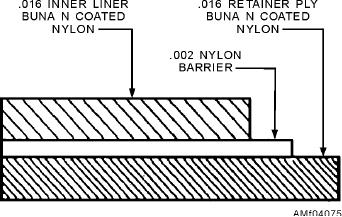
The nylon barrier consists of three to four coats of
These plies, baffles, internal bulkheads, and flapper
nylon applied hot by brush, swab, or spray. The purpose
valves with the necessary fittings and combinations
of the nylon barrier is to keep fuel from diffusing
make up a typical self-sealing fuel cell.
through the cell wall.
Bladder-Type Fuel Cells
The retainer consists of Buna N coated
square-woven fabric (cotton or nylon) or cord fabric.
A nonself-sealing fuel cell is commonly called a
The purpose of the retainer ply or plies is to lend
bladder cell. It is a fuel container that does not self-seal
strength to the fuel cell and provide protection for the
holes or punctures. The advantage of using a bladder
nylon fuel barrier.
fuel cell results from the saving in weight. Some of the
other advantages are the simplicity of repair techniques
NYLON-TYPE BLADDER CELLS
and the reduced procurement costs over self-sealing
(PLIOCEL).--Nylon bladder cells differ in
fuel cells.
construction and material from the Buna N rubber cells.
This type of cell may be identified by the trade name
Bladder-type cells are usually made of very thin
"Pliocel" stenciled on the outside of the cell. The
material to give minimum possible weight. They
Pliocel construction consists of two layers of nylon
require 100-percent support from a smooth cavity. The
woven fabric laminated with three layers of transparent
cell is made slightly larger than the cavity of the aircraft
nylon film.
for better weight and distribution throughout the
aircraft's fuel cavity structure.
The repair of this type of cell must be accomplished
by entirely different methods and with different
The thinner wall construction increases the fuel
materials. The adhesive and Buna N rubber used to
capacity over the self-sealing cells, thus increasing the
repair the rubber-type bladder cell cannot be used on
range of the aircraft. Many of our aircraft that were
the nylon-type cell.
formerly equipped with self-sealing cells have been
changed to bladder-type cells.
INTEGRAL FUEL CELL REPAIR
There are two types of bladder fuel cells--rubber
type and nylon type.
Integral fuel cells are usually contained in the wing
structure; however, in some aircraft integral fuel cells
RUBBER-TYPE BLADDER CELLS.--The
are built into the fuselage. An integral cell is a part of
rubber-type bladder cells are made in the same manner
the aircraft structure that has been built in such a
as self-sealing cells. They have a liner, nylon barrier,
manner that after the seams, structural fasteners, and
and a retainer ply. The sealant layers are omitted. All
access doors have been properly sealed, it will hold fuel
three plies are placed on the building form as one
without leaking. This type of construction is usually
material in the following order: liner, barrier, and
referred to as a "wet wing."
retainer. Figure 4-75 shows this type construction.
Usually, the cell area is located between two spars,
The inner liner may consist of Buna N rubber, Buna
and is capped on the ends by sealed end ribs. The skin
N coated square-woven fabric (cotton or nylon), or
covering may be standard riveted sheet or may be
Buna N coated cord fabric. The purpose of the inner
milled from a solid plate of aluminum alloy. The milled
liner is to contain the fuel and provide protection for the
skins are usually bolted in place instead of being
nylon barrier.
riveted.
Figure 4-75.--Bladder cell construction.
4-48

